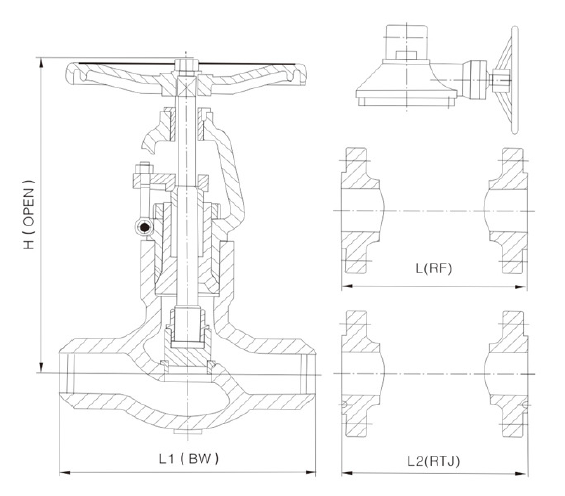Payment:
30% T/T When Order, 70% T/T Before ShipmentProduct Origin:
ChinaColor:
CustomizationShipping Port:
Shanghai ChinaLead Time:
35~60 days Ex Works After Order ConfirmationMaterial:
Carbon Steel Globe Valve, Cast Steel Globe ValveMethod of Operation:
Gearbox Operation Globe ValveQuick Detail
|
Type |
Globe Valve |
|
Size |
6'' |
|
Design Pressure |
Class 1500 |
|
Construction |
Pressure Seal Bonnet, Plug Type Disc, Rising Stem |
|
Connection Type |
Butt Weld |
|
Operation Type |
Bevel Gearbox Opearted |
|
Design Code |
BS 1873 |
|
End to End |
ASME B16.10 |
|
Connection End |
ASME B16.25 |
|
Pressure & Temperature |
ASME B16.34 |
|
Test & Inspection Standard |
API 598 |
|
Body Material |
Cast Steel WCB |
|
Trim Material |
Trim NO. 5 |
|
Temperature Range |
-29℃~+425℃ |
|
Application |
WOG |
|
Origin |
China |
Material & Dimension

NPS
DN
Class
2
2 1/2
3
4
6
8
50
65
80
100
150
200
L(RF) L1(BW)
900LB
368
419
381
457
610
737
1500LB
368
419
470
546
705
832
2500LB
451
508
578
673
917
1022
L2(RTJ)
900LB
371
422
384
460
613
740
1500LB
371
422
473
549
711
841
2500LB
454
514
584
683
927
1038
H(Opne)
900LB
550
605
678
798
930
1230
1500LB
550
605
866
956
1260
1263
2500LB
560
720
755
1230
1791
2086
W
900LB
350
350
400
450
458
610*
1500LB
400
400
450
560
610*
610*
2500LB
400
450
560
310*
610*
760
Weight (RF)
900LB
78
108
102
142
400
960
1500LB
85
110
135
230
660
1590
2500LB
140
168
247
620
1500
3200
Weight (BW)
900LB
66
91
87
128
355
868
1500LB
77
101
122
209
595
1440
2500LB
100
118
180
438
1148
2594
*Manual gear
operator is recommended
No
Part Name
Carbon steel to
ASTM
Alloy
steel to ASTM
Stainless
steel to ASTM
WCB
WC6
WC9
C5
CF8
CF8M
CF3
CF3M
1
Body
A216 WCB
A217 WC6
A217 WC9
A217 C5
A351 CF8
A351 CF8M
A351 CF3
A351 CF3M
2
Seat Ring
A105
A182 F11
A182 F22
A182 F5
A182 F304
A182 F316
A182 F304L
A182 F316L
3
Disc
A105
A182 F11
A182 F22
A182 F5
A182 F304
A182 F316
A182 F304L
A182 F316L
4
Stem
A182 F6
A182 F304
A182 F304
A182 F316
A182 F304L
A182 F316L
5
Disc nut
A182 F6
A182 F304
A182 F304
A182 F316
A182 F304L
A182 F316L
6
Cap
SS Spiral Wound graphite or
SS Spiral Wound PTFE
7
Body Seal
Flexible Graphite+316
8
Adjustment Gasket
F6
F6
F316
9
Stem packing
Flexible Graphite+316
10
Gland Nut
A194 2H
A194 8
11
Gland Eyebolt
A193 B7
A193 B8
12
Pin
Carbon steel or Stainless
Steel
13
Cap Nut
Carbon steel or Stainless
Steel
14
Gland
A182 F6
A182 F304
A182 F316
A182 F304L
A182 F316L
15
Gland Flange
A216 WCB
A351 CF8
16
Yoke
A216 WCB
A351 CF8
17
Stem Nut
A439 D2 or B148-952A
18
Screw
Carbon steel
19
Handwheel
Ductile Iron or carbon
steel
20
Name Plate
Stainless steel or Aluminum
21
Washer
Carbon steel
22
Nut
Carbon steel or Stainless
Steel
Related Knowledge
Why do we use
pressure seal bonnet?
Pressure sealed
bonnet are often used for valves with high design pressure. The higher the
internal pressure gets, the greater the sealing force beween body and bonnet
become.
For bolted bonnet
valves, the body and bonnet are joined by studs and nuts with a gasket between
the flange faces to facilitate sealing. However,as system pressure
increases,the potential for leakage through the body and bonnet increases.
But for pressure sealed valve, “bonnet take-up bolts” to pull the bonnet up and seal against the pressure seal gasket. That is why when pressure increase, the performance of pressure seal gasket between body and bonnet becomes better.
If you are interested in our products and want to know more details,please leave a message here,we will reply you as soon as we can.